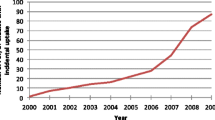Abstract
Background and Objectives
We assessed the ability of positron emission tomography–computed tomography (PET/CT) to detect synchronous colonic pathology and determined the significance of 18F-fluorodeoxyglucose (18F-FDG) activity in the colon of gastric cancer patients.
Methods
A total of 239 gastric cancer patients who underwent PET/CT and colonoscopy preoperatively were included. FDG uptake patterns on PET/CT were classified as (1) group A, focal; (2) group B, diffuse; and (3) group C, no uptake. The PET/CT findings were compared with the results of concurrent colonoscopy.
Results
In group A, a total of 123 polyps of >0 mm were observed. Of these, nine polyps were colonic adenocarcinomas and six were high-grade dysplasia. The incidence of colonic adenocarcinomas was significantly higher in group A than in the other two groups (p = 0.037). There was a significant correlation between SUVmax values and incidence of colonic polyps of >10 mm (r = 0.471, p = 0.04). The distribution pattern of SUVmax in polyps with adenoma (>10 mm) was less homogenous than in polyps (>10 mm) with adenocarcinoma.
Conclusions
The focal colonic FDG uptake in PET/CT requires colonoscopic confirmation. The suspicion of colonic malignancy increased in the presence of polyps >10 mm that showed a positive correlation with the SUVmax.




Similar content being viewed by others
References
Parkin DM, Bray F, Ferlay J, Pisani P.: Global Cancer Statistics: 2002. CA Cancer J Clin 2005; 55:74–108.
Kelley JR, Duggan JM.: Gastric Cancer Epidemiology and Risk Factor. J Clin Epidemiol 2003; 56: 1–9.
Kim JP.: Surgical Results in Gastric Cancer. Semin Surg Oncol 1999; 17:132–138.
Miller FH, Kochman ML, Talamonti MS, et al.: Gastric Cancer. Radiologic Staging. Radiol Clin North Am 1997; 35:331–349.
Park CH, Song KY, Kim SN.: Treatment Results for Gastric Cancer Surgery: 12 Years' Experience at a Single Institute in Korea. Eur J Surg Oncol 2008; 34:36–41.
Kim SK, Kang KW, Lee JS, et al.: Assessment of Lymph Node Metastases using 18F-FDG PET in Patients with Advanced Gastric Cancer. Eur J Nucl Med Mol Imaging 2006; 33:148–155.
Yeung HW, Macapinlac H, Karpeh M, et al.: Accuracy of FDG-PET in Gastric Cancer. Preliminary Experience. Clin Positron Imaging 1998; 1:213–221.
Chen J, Cheong JH, Yun MJ, et al.: Improvement in Preoperative Staging of Gastric Adenocarcinoma with Positron Emission Tomography. Cancer 2005; 103:2383–2390.
Song KY, Park SM, Kim SN, Park CH.: The Role of Surgery in the Treatment of Recurrent Gastric Cancer. Am J Surg 2008; 196:19–22.
Maehara Y, Hasuda S, Koga T, et al.: Postoperative Outcome and Sites of Recurrence in Patients following Curative Resection of Gastric Cancer. Br J Surg 2000; 87:353–357.
Otsuji E, Yamaguchi T, Sawai K, et al.: Recent Advances in Surgical Treatment have Improved the Survival of Patients with Gastric Carcinoma. Cancer 1998; 82:1233–1237.
Cook GJR, Fogelman I, Maisey MN.: Normal Physiological and Benign Pathological Variants of 18-Fluoro-Deoxyglucose Positron Emission Tomography Scanning: Potential for Error in Interpretation. Semin Nucl Med 1996; 26:308–314.
Kostakoglu L, Hardoff R, Mirtcheva R, et al.: PET-CT Fusion Imaging in Differentiating Physiologic from Pathologic FDG Uptake. Radiographic 2004; 24:1411–1431.
Gutman F, Alberini JL, Wartski M, et al.: Incidental Colonic Focal Lesions Detected by FDG PET/CT. AJR Am J Roentgenol 2005; 185:495–500.
Kamel EM, Thumshirn M, Truninger K, et al.: Significance of Incidental 18 F-FDG Accumulation in the Gastrointestinal Tract in PET/CT: Correlation with Endoscopic and Histopathologic Results. J Nucl Med 2004; 45:1804–1810.
Israel O, Yefremov N, Bar-Shalom R, et al.: PET/CT Detection of Unexpected Gastrointestinal Foci of 18-F-FDG Uptake: Incidence, Localization Patterns, and Clinical Significance. J Nucl Med 2005; 46:758–762.
Agress H, Cooper BZ.: Detection of Clinically Unexpected Malignant and Premalignant Tumors with Whole-Body FDG-PET: Histopathology Comparison. Radiology 2004; 23:417–422
Israel O, Mor M, Guralnik L, et al.: 18F-FDG PET/CT Useful for Imaging and Management of Patients with Suspected Occult Recurrence of Cancer? J Nucl Med 2004; 45:2045–2051
Kim S, Chung JK, Kim BT, et al.: Relationship between Gastrointestinal F-18-fluorodeoxyglucose Accumulation and Gastrointestinal Symptoms in Whole-Body PET. Clin Positron Imaging 1999; 2:273–279.
Weston BR, Iyer RB, Qiao W, et al.: Ability of Integrated Positron Emission and Computed Tomography to Detect Significant Colonic Pathology: The Experience of a Tertiary Cancer Center. Cancer 2010; 116:1454–1461.
Yasuda S, Shohtsu A, Tsutsumi Y.: Colonic adenoma detected by positron emission tomography (PET): a case report. Tokai J Exp Clin Med 1998;23:153–155.
Zhuang H, Hickeson M, Chacko TK, et al.: Incidental detection of colon cancer by FDG positron emission tomography in patients examined for pulmonary nodules. Clin Nucl Med 2002;27:628–632.
Yasuda S, Fujii H, Nakahara T, et al.: 18 F-FDG PET detection of colonic adenomas. J Nucl Med 2001;42:989–992.
Van Kouwen MC, Nagengast FM, Jansen JB, et al.: 2-(18 F)-Fluoro-2-deoxy-dglucose positron emission tomography detects clinical relevant adenomas of the colon: a prospective study. J Clin Oncol 2005;23:3713–3717.
Wong WM, Mandir N, Goodlad RA, et al.: Histogenesis of human colorectal adenomas and hyperplastic polyps: the role of cell proliferation and crypt fission. Gut. 2002;50:212-217.
Smyth E, Schöder H, Strong VE, et al: A prospective evaluation of the utility of 2-deoxy-2-[(18) F]fluoro-d-glucose positron emission tomography and computed tomography in staging locally advanced gastric cancer. Cancer. 2012; doi:10.1002/cncr.27550.
Author information
Authors and Affiliations
Corresponding author
Rights and permissions
About this article
Cite this article
Shim, J.H., O, J.H., Oh, S.I. et al. Clinical Significance of Incidental Colonic 18F-FDG Uptake on PET/CT Images in Patients with Gastric Adenocarcinoma. J Gastrointest Surg 16, 1847–1853 (2012). https://doi.org/10.1007/s11605-012-1941-3
Received:
Accepted:
Published:
Issue Date:
DOI: https://doi.org/10.1007/s11605-012-1941-3




